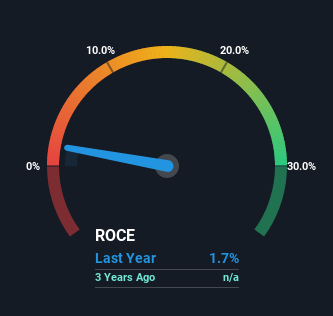The Return Trends At Playmaker Capital (CVE:PMKR) Look Promising

What are the early trends we should look for to identify a stock that could multiply in value over the long term? Ideally, a business will show two trends; firstly a growing return on capital employed (ROCE) and secondly, an increasing amount of capital employed. If you see this, it typically means it's a company with a great business model and plenty of profitable reinvestment opportunities. So when we looked at Playmaker Capital (CVE:PMKR) and its trend of ROCE, we really liked what we saw.
Return On Capital Employed (ROCE): What is it?
For those who don't know, ROCE is a measure of a company's yearly pre-tax profit (its return), relative to the capital employed in the business. The formula for this calculation on Playmaker Capital is:
Return on Capital Employed = Earnings Before Interest and Tax (EBIT) ÷ (Total Assets - Current Liabilities)
0.017 = US$1.2m ÷ (US$89m - US$19m) (Based on the trailing twelve months to March 2022).
So, Playmaker Capital has an ROCE of 1.7%. Ultimately, that's a low return and it under-performs the Media industry average of 9.1%.
View our latest analysis for Playmaker Capital

In the above chart we have measured Playmaker Capital's prior ROCE against its prior performance, but the future is arguably more important. If you're interested, you can view the analysts predictions in our free report on analyst forecasts for the company.
The Trend Of ROCE
The fact that Playmaker Capital is now generating some pre-tax profits from its prior investments is very encouraging. About two years ago the company was generating losses but things have turned around because it's now earning 1.7% on its capital. And unsurprisingly, like most companies trying to break into the black, Playmaker Capital is utilizing 2,219% more capital than it was two years ago. This can tell us that the company has plenty of reinvestment opportunities that are able to generate higher returns.
For the record though, there was a noticeable increase in the company's current liabilities over the period, so we would attribute some of the ROCE growth to that. Effectively this means that suppliers or short-term creditors are now funding 22% of the business, which is more than it was two years ago. Keep an eye out for future increases because when the ratio of current liabilities to total assets gets particularly high, this can introduce some new risks for the business.
Our Take On Playmaker Capital's ROCE
To the delight of most shareholders, Playmaker Capital has now broken into profitability. Since the total return from the stock has been almost flat over the last year, there might be an opportunity here if the valuation looks good. With that in mind, we believe the promising trends warrant this stock for further investigation.
One final note, you should learn about the 4 warning signs we've spotted with Playmaker Capital (including 1 which is significant) .
While Playmaker Capital isn't earning the highest return, check out this free list of companies that are earning high returns on equity with solid balance sheets.
New: Manage All Your Stock Portfolios in One Place
We've created the ultimate portfolio companion for stock investors, and it's free.
• Connect an unlimited number of Portfolios and see your total in one currency
• Be alerted to new Warning Signs or Risks via email or mobile
• Track the Fair Value of your stocks
Have feedback on this article? Concerned about the content? Get in touch with us directly. Alternatively, email editorial-team (at) simplywallst.com.
This article by Simply Wall St is general in nature. We provide commentary based on historical data and analyst forecasts only using an unbiased methodology and our articles are not intended to be financial advice. It does not constitute a recommendation to buy or sell any stock, and does not take account of your objectives, or your financial situation. We aim to bring you long-term focused analysis driven by fundamental data. Note that our analysis may not factor in the latest price-sensitive company announcements or qualitative material. Simply Wall St has no position in any stocks mentioned.
About TSXV:PMKR
Playmaker Capital
Playmaker Capital Inc. operates as a digital sports media company that lives at the intersection of sports, betting, media, and technology.
Reasonable growth potential with mediocre balance sheet.
Market Insights
Community Narratives



